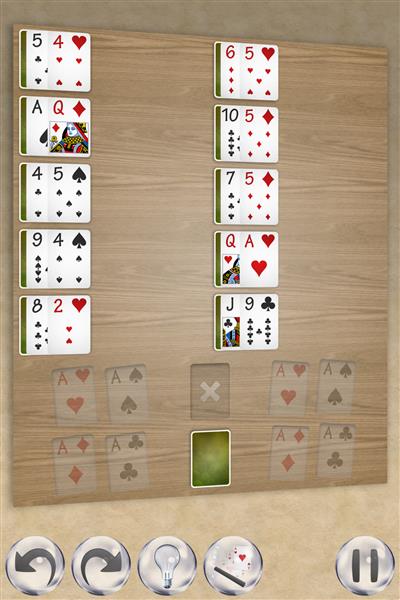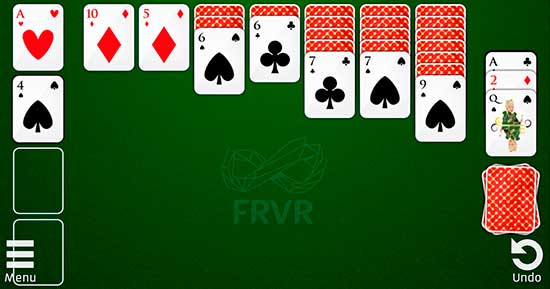

The Talon (or “Waste”) Pile: Cards from the stock pile that have no place in the tableau or on foundations are laid face up in the waste pile. The Stock (or “Hand”) Pile: If the entire pack is not laid out in a tableau at the beginning of a game, the remaining cards form the stock pile from which additional cards are brought into play according to the rules. The foundation piles are hearts, diamonds, spades, and clubs. In most Solitaire games, the four aces are the bottom card or base of the foundations. The Foundations: Four piles on which a whole suit or sequence must be built up. The Tableau: Seven piles that make up the main table. There are four different types of piles in Solitaire: The rank of cards in Solitaire games is: K (high), Q, J, 10, 9, 8, 7, 6, 5, 4, 3, 2, A (low).

The ultimate objective is to build the whole pack onto the foundations, and if that can be done, the Solitaire game is won. The first objective is to release and play into position certain cards to build up each foundation, in sequence and in suit, from the ace through the king. Standard Solitaire uses one 52-card pack. You can move cards around, but they can only go on cards that are 1 number higher and the opposite color.Virtually all Solitaire games are played with one or more standard 52-card packs. Keep playing like this until you’ve moved all of the cards into the corresponding suit piles in ascending order, or have run out of cards that you are able to move. Whenever you are stuck, you can continue flipping over sets of 3 cards from the reserve pile as long as you’d like, but make sure to never shuffle it. If you can’t, flip over 3 more cards from the reserve pile. If you can, play it and then see if you can play the card underneath it. Once you come to a point where you can’t move any more cards, flip over the top 3 cards from the reserve pile, and see if you can play the top card anywhere. Continue to move the face-up cards around the playing area and into the 4 suit piles. Then, when you encounter the 2 in that suit, play it on top of the ace, followed by the 3 in that suit, and so on. If you have a face-up ace, place it above the playing area to start one of the 4 foundation piles you need to win the game. When you move a face-up card and expose a face-down card underneath it, turn the face-down card over. You can move a face-up card to the bottom of another column if the face-up card you’re playing it on is a different color and one number higher than it. To start the game, look at the face-up cards to see if you can move any of them to access the face-down cards underneath. Place the remaining cards in a pile off to the side. Repeat until every column has a face-up card at the bottom. Once you finish all 4 foundation piles, you win! To set up the game, first place 1 card face up and 6 cards face down to the right. To play solitaire, try to get all of the cards into 4 foundation piles, 1 pile per suit, in ascending order from ace to king. Once all of the reserve cards have run out, you can take them from the discard pile and return them to the reserve pile so you can keep removing cards from the pyramid. If no cards can be made into pairs, the next reserve card is flipped over.The top card of the reserve deck can also be used to make 13. Kings are 13 points, queens 12, jacks 11 and the rest of the cards represent their face values (aces are 1.) For example, you could remove a king you could also remove an 8 and 5, because they add up to 13.

You can only remove cards that have a value of 13. Remove cards one at a time or in pairs.Create a reserve pile with the left over cards.Note that some people play that you only use 21 cards to make the pyramid. Each row should overlap the row above it. until all 28 cards have been placed in the pyramid. It should be stacked so that the rows are made of one card, then two cards, then three cards, etc.



 0 kommentar(er)
0 kommentar(er)
